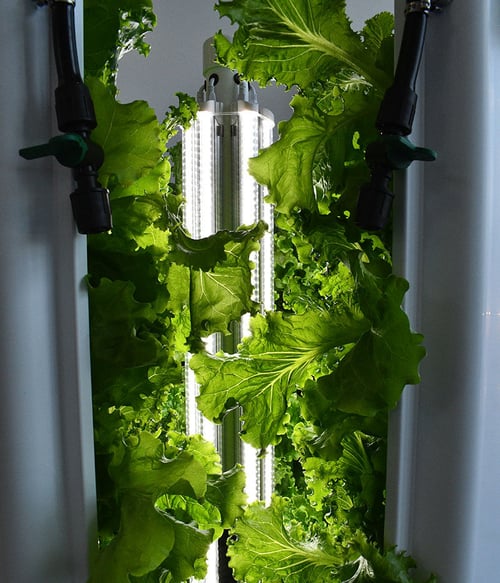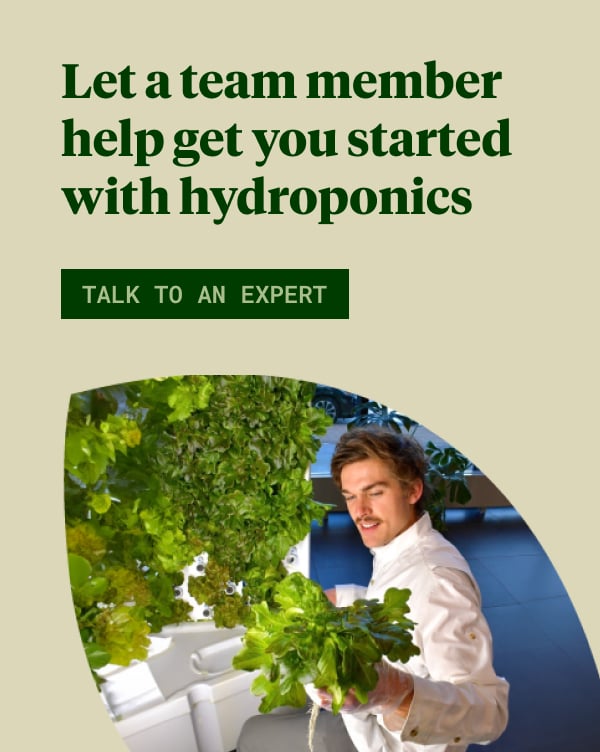A Beginner's Guide to Indoor Hydroponic Gardens and Farming
Hydroponics, a method of growing plants without soil, is rapidly becoming an extremely popular methodology for farming. The technique grows plants in a nutrient-rich water solution, allowing plants to grow faster and produce higher yields than traditional soil-based farming. As hydroponics grow plants in a controlled environment, growers get better control over factors like temperature, humidity, and lighting, which can greatly influence plant growth. In theory, this all sounds like an ideal solution for farming but is intimidating for new farmers or anyone experienced with traditional methods.
Due to its versatility, hydroponics is drawing a lot of aspiring growers. However, even with some basic knowledge of hydroponic gardening, it can be difficult to know where to start. Beginning with the benefits of hydroponic farming, in this post, we’ll review and discuss some ways to get started with hydroponics.
Benefits of Hydroponic Farming
Hydroponic farming offers a sustainable and efficient way to grow plants, providing gardeners with healthier and more abundant harvests. There are a lot of benefits of hydroponic farming, including:
- Faster growth: Plants grown hydroponically grow faster than those sprouted using traditional gardening methods. This is because they have direct access to nutrients, which allows them to focus their energy on growth rather than searching for nutrients in the soil.
- Higher yields: Hydroponic farming often produces higher yields than traditional gardening. With the proper nutrients and environmental conditions, plants can produce more leafy greens, fruits, and vegetables in a shorter period. Tomatoes, for instance, currently are the most extensively cultivated hydroponic crop worldwide.
- Pest and disease control: Since hydroponic farming is done in a controlled environment, preventing and controlling pests and diseases is easier. This reduces or eliminates the need for pesticides and other chemical treatments.
- Water conservation: Hydroponic farming is a water-efficient method as it recirculates the water used in the system. This significantly reduces water waste compared to traditional gardening.
- Space efficiency: Hydroponic systems can be set up in small spaces, making them ideal for urban gardeners, educators, or those with limited outdoor space. Vertical farming techniques can be used to maximize space utilization
With climbing food prices and the continued impacts of climate change, the benefits of hydroponics make it an ideal solution for the future of farming.
Choosing The Right Hydroponic System
When choosing a suitable hydroponic farm, it's important to consider the type of plants you want to grow, available space, budget, and experience level.
There are a few popular types of hydroponic systems.
- Deep Water Culture (DWC): DWC is a simple and cost-effective system, making it ideal for beginners. DWC suspends plants in a nutrient-rich water solution with their roots submerged. Then, air stones or diffusers provide oxygen to the roots.
- Nutrient Film Technique (NFT): NFT systems are popular for their simplicity and suitability for growing leafy greens and herbs. The systems involve a thin film of nutrient solution flowing over the roots of the plants. The excess solution is then collected and recirculated.
- Drip System: Drip systems involve a timer-controlled pump that delivers a nutrient solution to the plants using drip emitters. This system allows for precise control over nutrient delivery and is suitable for various plants.
- Aeroponics: In aeroponic systems, plants are suspended in the air, and their roots are misted with a nutrient solution. This method provides excellent oxygenation to the roots and is known for its high growth rates.
Overall, it’s important to choose the right system that suits your needs and available space.
Essential Components for an Indoor Hydroponic Farm
When investing in an indoor hydroponic farming system, there are a few vital components to consider.
- Growing containers/plant spots: Trays, buckets, or specialized containers are designed for hydroponic farming. They should be able to hold the plants and the growing medium.
- Growing medium: This material supports the plants and their roots. Common examples include rock wool perlite, vermiculite, and coconut coir.
- Nutrient solution: This mix of water and specific nutrients is required for plant growth. It should contain all the necessary macro and micronutrients in the right proportions and include pH adjusters for optimum growth.
- pH and TDS meters: These tools are used to monitor the pH and nutrient levels (total dissolved solids). Maintaining the correct pH and nutrient levels is crucial for plant health and nutrient uptake.
- Lighting: Since hydroponic farming is often done indoors or in controlled environments, artificial lighting is required. LED grow lights are popular for their energy efficiency and ability to provide the right spectrum of light for plant growth.
Water pump: These pumps are used to circulate the nutrient solution and provide oxygen to the roots.
Researching and understanding the pros and cons of each system will help make an informed decision.
Getting Started with Indoor Hydroponic Farming
When getting started with indoor hydroponic farming, a few crucial steps include:
- Research and plan: Learn more about different hydroponic systems, plants suitable for hydroponic gardening, and the specific requirements of each plant. Then, you can decide on the system that best fits your needs and available space.
- Set up your system: Purchase or build the components for your chosen hydroponic system. Install the system in a suitable location, ensuring access to electricity, water, and proper ventilation.
- Prepare the nutrient solution: Follow the instructions provided with your nutrient solution to mix it properly. Monitor and adjust the pH and TDS levels as required. If this part is challenging, our Farmative community is full of growers who have undergone the process before and can help.
- Plant and transplant your crops: Start with seeds or young seedlings and carefully place them in the growing medium. Ensure the roots are adequately covered and supported.
- Monitor and maintain: Regularly check the pH and TDS levels of the nutrient solution and make adjustments as needed. Monitor the plants for signs of nutrient or pH deficiencies and take appropriate action.
- Harvest and enjoy: As plants grow, you can start harvesting healthy foods like leafy greens, fruits, and vegetables. Hydroponic farming may require some trial and error as you learn to balance nutrient levels and environmental conditions.
Throughout the process, you can experiment and make adjustments along the way.
Flex Farm Indoor Hydroponic Garden Solution
In our opinion, Flex Farm is the most efficient, scalable, and transformative indoor, vertical hydroponic technology on the planet. Our technology uses the best components from different hydroponic systems - for example, NFT and Drip.
A few other advantages and highlights of Flex Farm include:
- They’re portable and only require a standard electrical outlet and less than 10 square feet of space
- Grow 25+ lbs of fresh food every 28 days
- Harvest up to 3,400 plants annually
- Requires 2 hours of regular maintenance per month
The Flex Farm is a Farm in a box and takes less than an hour to set up. Ideal for beginners, it comes with everything you need to start farming. It has a fully self-contained water system, energy-efficient LED light tower, submersible pump, Grower Toolkit, and Starter Supplies Box.
If you run into issues or challenges, we offer comprehensive support. The Fork Farms team has end-to-end support from our hydroponics experts and access to the Farmative community, where you can collaborate with other growers. The pre-sale, onboarding, and ongoing support from the Fork Farms partner team all but guarantee growing success. By carefully controlling everything plants need to thrive, each Flex Farm can grow more than 394 pounds of produce annually.
Pursue Hydroponic Farming with Flex Farms
With time and practice, many people can become skilled hydroponic gardeners. Like any new skill, hydroponic farming has a learning curve, but getting started is easy with the right resources and support.
Ready to move forward? The Flex Farm is scalable, transformative, and one of the best indoor, vertical hydroponic technology options.
Subscribe to our blogs
Is the Flex Farm right for you?
Connect with an expert member of our team and let’s work together to bring your growing experience to life. To help get you connected with the best person, please tell us where you are located.



